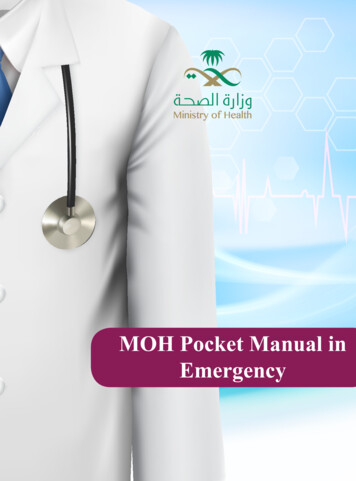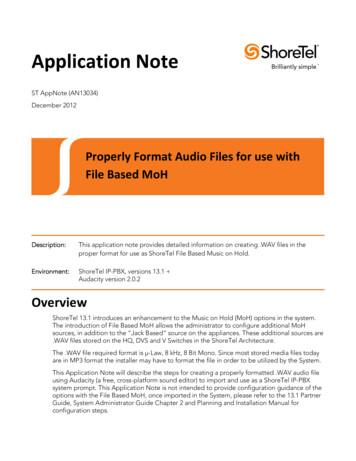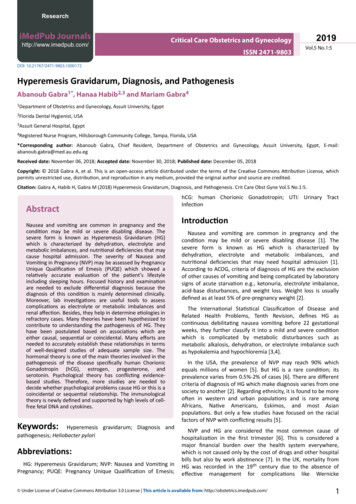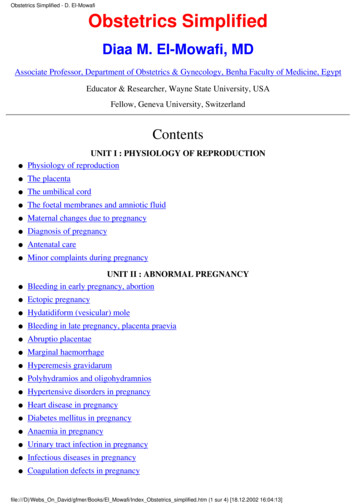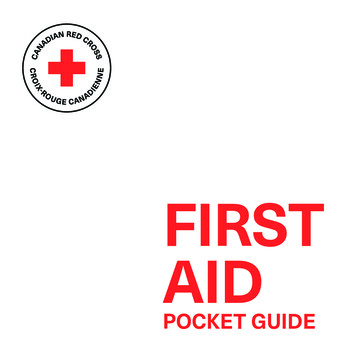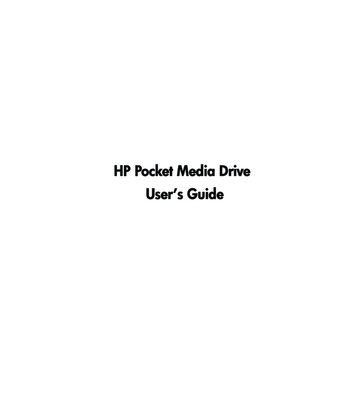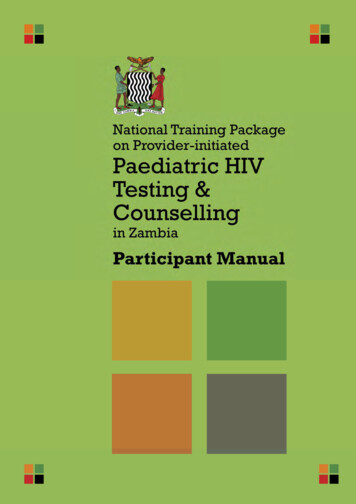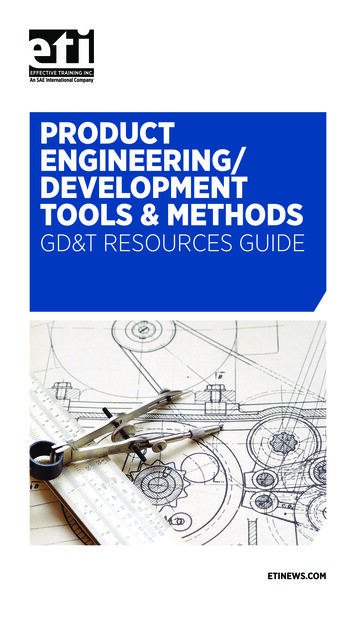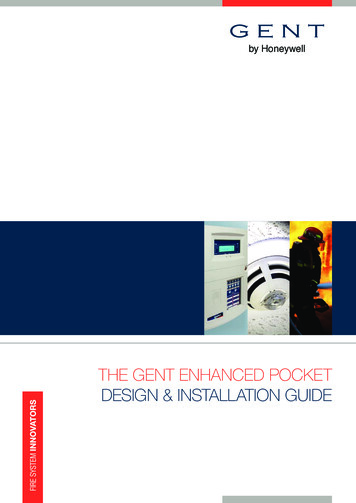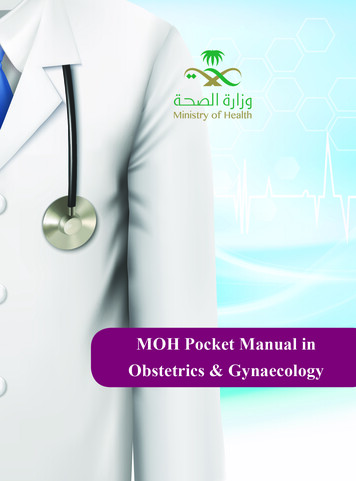
Transcription
MOH Pocket Manual in Obstetrics & GynaecologyOBSTETRICS & GYNAECOLOGYPOSTPARTUM HAEMORRHAGESHOULDER DYSTOCIAPRE ECLAMPSIAPLACENTA PREVIA AND ACCRETACORD PROLAPSEPRETERM LABOURPRETERM PREMATURE RUPTUREOF MEMBRANESMALL FOR GESTATIONAL AGEREDUCED FETAL MOVEMENTPERIPARTUM HYSTERECTOMYCAESAREAN SECTIONBREECH IN LABOURINTRAUTERINE FETAL DEATHINDUCTION OF LABOURINDUCTION OF LABOUR INLABOUR ROOMTWIN PREGNANCYTWINS IN LABOURCARDIAC DISEASE IN PREGNANCYMANAGEMENT OF DICMANAGEMENT OF 3RD STAGEOF LABOUR, RETAINED PLACENTA AND ACUTE UTERINE INVERSION3
MOH Pocket Manual in Obstetrics & GynaecologyMANAGEMENT OF PATIENT ONANTI – COAGULANTINSTRUMENTAL DELIVERYPERIMORTEM CAESAREAN SECTIONMANAGEMENT OF HIV IN PREGNANCYECTOPIC PREGNANCYSEPTIC SHOCK3RD AND 4TH DEGREE PERINEAL TEARGESTATIONAL TROPHOBLASTIC DISEASEEPISIOTOMYMANAGEMENT OF COUPLE WITH RECURRENT ABORTIONEARLY PREGNANCY LOSS MANAGEMENTMENORRHAGIAMANAGEMENT OF HEMATOMAS RESULTING FROM OCDELIVERYANTENATAL CAREMANAGEMENT OF DIABETESIN PREGNANCY ( GDM )4
MOH Pocket Manual in Obstetrics & GynaecologyPOST PARTUM HEMORRHAGEOVERVIEW: Postpartum Haemorrhage is an obstetrical emergency andis a major cause of maternal morbidity and one of the topthree causes of maternal mortality. The incidence varies between 1-5% of deliveries. PPH is either primary occurring within 24 hours after delivery and secondary occurs 24 hours-12 weeks after delivery. Defined clinically as excessive bleeding after delivery thatmakes the patient symptomatic (e.g pallor, palpitation,weakness, restlessness, hypotension, tachycardia, oxygensaturation 95%). Another classic definition is a 10 percent decline in postpartum hemoglobin concentration from antepartum levels A less useful definition of estimated blood loss 500 mlafter vaginal birth or 1000 ml after cesarean delivery.WORK UP: It is a team work. Detect the risk factors for postpartum haemorrhage, counseling and planning for delivery.5
MOH Pocket Manual in Obstetrics & Gynaecology Consultant on call or Specialist should be informed to assess the case if needed. All patients with risk factors for postpartum haemorrhageshould have blood cross match and ready. Most risk factors are unpredictable but can be preventable,majority of cases of PPH have no identifiable risk factor:ØSuspected abruption placentaØPlacenta previaØMultiple pregnancyØMultiparityØPETØRetained placentaØOperative vaginal deliveryØOver distended uterusCauses of PPH:§§Uterine atonyTrauma of cervix ,vagina or ruptured uterus 20% - 30%Retained placenta680%10%
MOH Pocket Manual in Obstetrics & Gynaecology§ Coagulation defect 1%Prediction & prevention of postpartum haemorrhage:Active management of 3rd stage of labour by: oxytocin (5 international unit I.V or 10 iu by intramuscular “ STAT ” with 0.2 mg. of Methergin ( if no contraindication) Control cord traction will reduce blood loss Alert about the patient with risk factors Activate the Protocol of Postpartum haemorrhage Postpartum Cart with medication and instrument Clinical drillMANAGEMENT:It is a team work.-Multidisciplinary approach: Experienced midwife Senior Obstetrician7
MOH Pocket Manual in Obstetrics & Gynaecology Alert Consultant obstetrician on call. Alert Anesthesiologist Alert the Blood Bank Alert the Haematologist as neededAlert one member of the team to record events, fluids,drugs and vital signs.Resuscitation by :2.a)Assess airway , breathing.Give oxygen mask at 10 – 15 L/minute.Evaluate circulation.Assess the vital signs every 10 – 15 minutesb)Oxygen saturationc)Foley’s catheterd)I.V. line with 2 big cannula, infuse crystalloid solution(Ringer Lactate) – 3 Liters: for every1.1 liter of blood loss.2 Liters Crystolloid 1 -2 colloid ( PlasmaProtein) until blood arrive.e) Cross match 4 units of PRBC and 2 units of Fresh Frozen8
MOH Pocket Manual in Obstetrics & GynaecologyPlasma.Recombinant factor VIIa therapy should be based on the resultsof coagulation.3. If patient is in hypovolemic shock:3.13.2Head tilt down.Keep patient warm.3.3 Check for Coagulation Profile ( PT, PTT, Fibrinogen,FDP, D- Dimer)3.4Send for CBC, LFT, RFT, ABG as baselineevery 30 minutes3.5 Consider central, arterial line3.6 ECG4. Commence Record Chart.Blood transfusion:1.Blood transfusion is the volume replacement best andshould be started as soon as possible.Preparation of blood products should be as:9
MOH Pocket Manual in Obstetrics & Gynaecology 6 units of PRBC 6 units of Fresh Frozen Plasma 6 units of Platelets 10 units of cryoprecipitate2.Aim to maintain: Hb 8 g/dl Platelet 75 x 10 9 Prothrombin 1.5 Fibrinogen 1 gm.Identify the causes of postpartum haemorrhageA.If uterine atony is suspected : Bimanual uterine massage Empty the bladder Insert 2 large bore I.V. cannula Start syntocinon drip 40 units in 500 cc. LR Methergin 0.2 mg. IM, if there is no contraindications, repeat10
MOH Pocket Manual in Obstetrics & Gynaecologyit as needed. If still no response, start Carboprost Protocol - 0.25 mg(contraindicated in women with asthma ) IM every 15 minutes for maximum 8 doses Misoprostol 1000 microgram per rectal ( 1 Tablet 200microgram)Total of 5 tabs.If patient is still bleeding, initiate subsequent intervention.1. Uterine Balloon Tamponade ( Bakri Ballon) after ensuring ifno placental remnants.- Insert either post vaginal deliveryor during caesarean section.2. Or intrauterine packing during caesarean section to controllower segment uterine bleeding. If patient is still bleeding and/or is haemodynamicallyunstable, proceed for laparotomy.Procedure during laparotomy to control haemorrhage ofatonic uterus:1.External uterine compression suture: B- lynch11
MOH Pocket Manual in Obstetrics & Gynaecology2.Uterine artery ligation3.Internal iliac artery ligation4.Arterial embolization (If available and arranged before)5.Hysterectomy, the last resort but it should be decided forpatients who are unstable with persistent heamorrhage toprevent DIC and death. It has to be decided after the opinionof two Consultants and informing the husband.B.In case of retained product:1. Manual removal of placenta under Ultrasound guidance.2. Suction and evacuation.C.In case of vaginal or cervical laceration or uterinerupture:1.Patient should be taken for laparotomy for repair of theinjury and control of bleeding.Once the bleeding has been controlled,continuous monitoring and observation in ICU.12
MOH Pocket Manual in Obstetrics & GynaecologyALERT:1.Vaginal bleeding after delivery may not appear abnormalin symptomatic patient were physician must role out intraabdominal bleeding relate to cesarean section or broad ligament or vaginal hematomas.2.Management of PPH is a team work and depend on thecause of bleeding, therefore early involvement of the mostsenior obstetrician is essential.3.Activate the massive blood loss 2.5 liter protocol as earlyas possible to ensure proper and volume replacement.4.Hysterectomy is the last resort method for controlling hemorrhage and must be decided by two consultants after explaining to the husband.5.Documentation : It is important to record:the staff in attendance and the time they arrivedthe sequence of eventsthe time of administration of different pharmacologicalagents given, their timing and sequencethe time of surgical intervention,where relevantthe condition of the mother throughout the different steps13
MOH Pocket Manual in Obstetrics & Gynaecologythe timing of the fluid and blood products given.References: WHO Guideline RCOG 200914
MOH Pocket Manual in Obstetrics & GynaecologySHOULDERDYSTOCIAOVERVIEW: Shoulder dystocia occurs when the descent of the anteriorshoulder is obstructed above the symphysis pubis. occurs in 0.2 to 3 percent of all birthsWORK UP: Shoulder dystocia is diagnosed when normal delivery maneuvers fails to deliver the body after the delivery of thehead. Shoulder dystocia cannot be predicted or prevented . The relationship between fetal size and shoulder dystociais not a good predictor. The majority of the cases occur in women with no riskfactor.MANAGEMENT: Call for help immediately including the most senior obstetrician, neonatologist . Assist the woman in recumbent position with her buttocksat the edge of the bed to assist access for the deliveringphysician.15
MOH Pocket Manual in Obstetrics & Gynaecology Use the HELPERRD nemonic.H - Call for help.E - Consider episiotomy which may improve access forinternal manoeuvers.L - Legs – McRoberts maneuvre . Ensure that the woman is in arecumbent position. Support the thighs into a hyperflexedposition on the abdomen.P - Pressure: Constant suprapubic pressure ( also known as Rubin I) initially if unsuccessful a rocking motion may be used.The doctor applies gentle downward pressure to the babywhile the assistant performs supra -pubic pressure over theanterior shoulder.E - Enter : Rubins 2 : Enter the vagina from below and apply thedigital pressure to the posterior aspect of the anterior shoulder towards the baby’s chest.Woods Screw: Maintain Rubin 2 maneuver and add asecond hand to apply pressure to the anterior aspect of posteriorshoulder.Reverse Wood Screw : Apply digital pressure to the posterior16
MOH Pocket Manual in Obstetrics & Gynaecologyaspect of the posterior shoulder to rotate it 1800R - Remove posterior arm: The delivering doctor passes his/her hands into the vagina over the baby’s chest locating theposterior arm. Apply pressure to the antecubital fossa to flexthe elbow in front of the body. Sweep the arm across thechest to deliver the arm and rotate the baby into the obliquediameter of the pelvis to assist birth.R - Roll on all fours: may increase pelvic diameters, and repeatall above maneuvers again.D - Debrief and document procedures. Elective cesarean section is not recommended to reducethe potential morbidity for pregnancies complicated bysuspected fetal macrosomia without maternal DM. There is no evidence that any one maneuvers is super toanother in releasing an impacted shoulder or reducing thechance of injury. However, performance of MacRobertmaneuver is reasonable initial approach. There is no advantage between delivery of the post armand internal rotation maneuvers and therefore clinicaljudgment and experience can be used to decide the order.17
MOH Pocket Manual in Obstetrics & Gynaecology Third line maneuvers require careful consideration toavoid unnecessary morbidity and mortality. (Clidotomy,Symphysiotomy, Zavanelli ).ALERT:Accurate timed documentation of a difficult and potentiallytraumatic delivery and the outcome is essential. 18RCOG March 2012
MOH Pocket Manual in Obstetrics & GynaecologyMANAGEMENT OF PRE - ECLAMPSIAOVERVIEW: Pre- eclampsia is recognized clinically by the presence ofhypertension or - proteinuria. Serious complications:-Eclamptic seizures-Disseminated Intravascular Coagulation-Cerebral haemorrhage-Acute liver or renal impairment-Abruptio placentaWORK UP: Investigations:-CBC, Hematocrit, Platelets, Blood Group and CrossMatchingRenal Function Test including Uric AcidLiver Function TestCoagulation Profile24 hours Urine collection for proteinECG, Chest X – Ray ( if indicated)19
MOH Pocket Manual in Obstetrics & GynaecologyRepeat investigations every 6 – 12 hours according to thepatient condition.MANAGEMENT:Admission to the hospital. Careful assessment of patient with pre – eclampsia shouldinclude the following:-Blood pressure ( using manual as well as automatedsphygmomanometer), monitor vital signs every 15minutes initially, then every 30 – 60 minutes according to the case.-Urinalysis for protein by dip stick every 4 hours andurinary output monitoring.-Auscultation of heart and lung fields-Abdominal palpation for epigastric or liver tenderness.Assessment of fetal size, presentation and well beingand liquor volume)-Examination of the optic fundus-Tendon reflexes and clonus Stabilization:20( CTG
MOH Pocket Manual in Obstetrics & Gynaecology-Control BP, monitor the patient’s symptoms.-Monitor fluid intake and urine output ( 100 ml. every 4hours and intake not to exceed 150 ml./hour. Treatment Goals:1)Prevent seizures:Magnesium sulphate:-Initial Dose: 4- 6 gms in 50 ml. over 15 – 20 minutesfollowed byMaintenance Dose : 1 – 2 gms/hour-Monitor for magnesium toxicity and corelate with serummagnesium level.-If significant toxicity is severe - give antidote( Calcium Gluconate 1 gm. ( 10 ml. of 10%solution slowly over 5 – 10 minutes).2)Stop Magnesium Sulphate at least 24 hours after the lastfits or 24 – 48 hours postpartum.Lower blood pressure:If BP 160/100 ( severe hypertension) start:21
MOH Pocket Manual in Obstetrics & GynaecologyAGENTDOSAGE1.) LABETALOLOR2.) NIPEDIFINEOR3.) HYDRALAZINEStart with 20 mg. IV, repeat at 20 – 80 mgIV every 30 minutes or 1 – 2 mg/min, max)300 mg. ( then switch to oralmg. capsule to be bitten and swal 10 – 5lowed or just swallowed every 30 minutes10 mg. tablet orally every 45 minutes to amaximum 80 mg./dayStart with 5 mg. IV, repeat 5 – 10 mg.IV every 30 minutes to a maximum of 20. mg IVIf mild hypertension start:AGENTmg. Orally BID– QID ( 500 - 2501.) LABETALOLmg. Orally BID – TID 400 – 100OROR2.) NIPEDIFINE22DOSAGE1.) METHYLDOPA)max. 2 g/day)Max. 1200 mg/day (Oral Tablets ( 10 – 20 mg. Orally)BID – TID ( Max. 180 mg./day
MOH Pocket Manual in Obstetrics & Gynaecology3) Management of Eclamptic Seizures:-Call for help, inform Specialist or Consultant on call.-Protect airway ( assess airway , breathing, check pulse &blood pressure) . Put patient in left lateral , suction & oxygen supplementation.-Give Magnesium Sulphate to abort the fits ( dose 4 – 6gms diluted in 50 ml. of fluid followed by continuous infusion of 1 - 2 gms./hour )-Prevent maternal injury-Once stabilized, assess the fetal condition by CTG andUSG, plan should be made to deliver the patient Delivery:Vaginal delivery can be considered but if delivery is remoteor unfavorable cervix, then caesarean sectionmay be required. Postpartum:-Monitor in Labour Room or if post operatively in ICU asindicated for at least 24 – 48 hours or until the patient isconsidered to be out of danger from the complications ofeclampsia.23
MOH Pocket Manual in Obstetrics & GynaecologyMonitor the vital signs every 2 hours while patient is on Magnesium Sulphate drips.- Repeat laboratory test until 2 consecutive sets of test arenormal according to the case.-Input – Output chart should be recorded hourly.-If BP is still high post delivery, consider Methydopa orLabetalol orally. If this is not sufficient, add Nipedifine slowrelease 20 mg. once or twice /day.ALERT: Avoid diuretics and Beta Blockers. Don’t give Diazepam or Phenytoin to abort the fits.References:24 Canadian Guideline 2010 RCOG , March 2006 William 24th Edition
MOH Pocket Manual in Obstetrics & GynaecologyPLACENTA PREVIA & ACCRETAMANAGEMENTOVERVIEW:Abnormally located placenta in the lower uterine segmentover the cervical os ( major placenta previa) or just reachingthe os ( minor placenta previa).WORK UP: Diagnosed by ultrasound ( abdominally or vaginally). MRI for any suspicion of accreta or precreta. CBC , Blood grouping, Cross - matching.MANAGEMENT: Maintain pre operative Hb. 9 – 10 g/dl. Asymptomatic minor previa follow up patient , till 36weeks as out patient, then admit to hospital and electivecaesarean section at 38 weeks. Asymptomatic major previa , do proper counseling eitherto keep in hospital till delivery or follow up as out patientprovided closed proximity with the hospital. Symptomatic ( history of bleeding ) with major placentaprevia , admit to hospital from 34 weeks of gestation.25
MOH Pocket Manual in Obstetrics & Gynaecology Give prophylactic thromboembolic stocking. Encourage gentle mobility. If at risk of DVT, give prophylactic anti coagulant ashospital protocol. Elective caesarean section should be planned at 38 weeksunless severe bleeding occur. If accreta is suspected, arrange for uterine artery embolization or internal iliac artery ligation depending on thefacility and delivery at 36 – 38 weeks.Placenta can be left in place or to proceed for hysterectomy , ifthere is severe bleeding.In massive haemorrhage : Give uterotonic agents Bi manual compression Uterine packing B-Lynch Uterine or internal iliac ligation Hysterectomy26
MOH Pocket Manual in Obstetrics & GynaecologyALERT: No P/V examination for APH patient , unless placenta previa is roled out. Caesarean section should be done by the most experienced obstetrician or refer patient to higher center. Blood should be available in OR before starting the procedure.References: RCOG Green Top Guideline No. 27, January 2011 The Sixth Report of Confidential Enquires into MaternalDeath in UK , 200427
MOH Pocket Manual in Obstetrics & GynaecologyCORD PROLAPSEOVERVIEW:Cord prolapsed occur when the umbilical cord lies beforethe presenting part after rupture of the membranes ( forewaters). If the forewaters are still intact it is defined as cordpresentation.WORK UP:Cord prolapse is diagnosed by vaginal examination whichmust be performed immediately after spontaneous rupture ofthe membranes.Fetal heart beat must be checked once the diagnosis is made.MANAGEMENT: The person making the diagnosis must keep his/her handsin the vagina in attempt to keep the cord from being compressed by the presenting part. The woman should be asked to assume the knee chest position as it seems likely that will relieve cord compression orto put patient head down ( trendling position). The fetal heart should be monitored. If less than fully dilated and fetus is viable, an immediate28
MOH Pocket Manual in Obstetrics & Gynaecologycaesarean section is considered. If the cervix is fully dilated and head engaged , obstetricianmay decide instrumental delivery. If the cord is prolapsed outside the vagina, dehydration andspasm of the cord vessel is possible,so should be replaced it in the vagina. The Paediatrician should be present at delivery time. Following delivery, arterial and venous cord blood shouldbe taken for blood analysis.ALERT:Fetal heart beat monitoring and status is essential to decideabout the operative delivery. Immediate action should be done to avoid serious neonatalmorbidity and mortality.References: William 24 Edition29
MOH Pocket Manual in Obstetrics & GynaecologyPRETERM LABOUROVERVIEW:Defined as labour pain at 24 weeks and less than 37 completed weeks gestation with at least 2 painful contractionsevery 10 minutes , cervical changes with: Cervical dilation 2 cm. ( 1 – 3 cm) or effacement 50 % or change in cervical dilatation or effacement by serial examination.WORK UP: Patient assessment abdominally & vaginally. Fetal monitoring – CTG, ultrasound to exclude fetal abnormality.MANAGEMENT: A plan of management should be decided by the most seniorobstetrician available in conjunction with the Paediatricianteam. In utero transfer , if needed it should be arranged. Steroid therapy may be effective in maturing the fetal lungs,and to reduce the incidence and severity of neonatal respiratory distress syndrome , given up to 36 weeks gestational age (Dexamethazone 12 mg. I.M. every 12 hours for 2doses). Epidural analgesia is ideal if available. Other analgesia tobe minimized.30
MOH Pocket Manual in Obstetrics & GynaecologyTocolytics when waiting for Corticosteroid action or intra –uterine transfer in presence of the uterine contraction.24 – 32 Week:Prostaglandin Synthetase Inhibitor :Indomethacin 50 - 100 mg Rectally loading then 25 mg.Orally every 4 – 6 hours x 48 hoursor Calcium Channel BlockersNifedipine - 20 mg orally then 10 – 20 mg. every6 – 8 hours up to 48 hours32 – 34 Week:1- Nifedipine or2-ß – Adenergic Receptor Agonist:A.Ritodrine - 100 mg. Ritodrine HCL in 500 ml LR , 15 ml/hr 0.05 mg/min.Monitor the patient to detect :ØFHR 180 baselineØMaternal pulse 140ØMaternal BP 90/5031
MOH Pocket Manual in Obstetrics & GynaecologyØECG changesØHypotension unresponsive to position changeØRespiratory symptoms: tachycardia, shortness ofbreath, chest painØExcessive maternal nervousness, palpitations,tremors or headacheØB.Vaginal bleedingTerbutalineIV Infusion - 2.5 - 5 mcg/min. increased by1.5 – 5 mcg/min. every 20 – 30 minutes to a maximum dose 25mcg/min. till uterine contraction stops.Then reduce the dose to the lowest dose that maintain theuterine quiescence.1.Atosiban (Tractocile)Initial bolus dose of 6.75 mg. over one minute followed byan infusion of 18 mg/hr. for 3 hours, then 6 mg./hr for up to45 hours ( to a maximum of 330 mg).32
MOH Pocket Manual in Obstetrics & Gynaecology3-Magnesium Sulphate4 - 6 gms. Loading dose over 20 minutes2 – 4 gms continuous infusion4-Antibiotics - Avoids broad spectrum antibioticØAntibiotics are used as prophylaxis against Group B Beta –Streptococcus only( Ampicillin 2 grams IV every 6 hours).ALERT: Preterm birth is a leading cause to neonatal mortality. Nifedipine and atosiban appear to have comparable effectiveness in delaying delivery, with fewer maternal adverse effects and less risk of rare serious adverseevents than alternatives such as ritodrine or indomethacinReferences: William 24th Edition33
MOH Pocket Manual in Obstetrics & Gynaecology RCOG October 2010 RCOG February 201134
MOH Pocket Manual in Obstetrics & GynaecologyPRETERM PREMATURE RUPTURE OFMEMBRANE( PPROM )OVERVIEW: PPROM is the rupture of membrane before 37 weeks ofgestation. Premature rupture of membrane ( PROM) : is the ruptureof the fetal membrane before the onset of labour. Antibiotics should be administered to patient withpreterm PROM to prolong the latent period and improveoutcomes. Corticosteroids should be given to patient with PPROMbetween 24 and 34 weeks to decrease the risk of intraventricular hemorrhage , respiratory distress syndrome andnecrotizing enterocolitis.WORK UP:1.Diagnosis of Preterm PROM: History suggestive of Preterm PROM:2.Sudden gush of fluid or continued leakage of fluid.Physical Examination:35
MOH Pocket Manual in Obstetrics & Gynaecology Check nitrazine paper for PH level and slides for ferning, if it is available. Check for leakage from the cervical os with coughing orfundal pressure. Sterile Speculum examination for dilatation , effacement,cord prolapsed and obtain culture and pooling amnioticfluid Perform ultrasonography for fluid index. AmniSure (AmniSure International LLC,Boston, MA, USA), a rapid immunoassay, has been shown to beaccurate in the diagnosis of ruptured membranes with asensitivity and specificity of 98.9% and 100%, respectivelyMANAGEMENT:1)Preterm PROM confirmed:Delivery regardless of gestational age if evidence of intraamniotic infection, significant abruption, cord prolapsed oractive labour and severe bleeding, life threatening medicaldisease, fetal demise.2)24 – 33 weeks:Expectant Management includes:36
MOH Pocket Manual in Obstetrics & GynaecologyHospital admission.Periodic assessment for infection , abrupt placenta and cordprolapsedFetal well beingSerial monitoring of leucocyte count and other markers ofinflammation have not been proved to be useful and are nonspecific when there is no clinical evidence of infection. Delivery should be considered at 34 weeks of gestation. Administer corticosteroid and antibiotics.-Dexamethazone 12 mg. every 12 hours for 2 doses I.M.-Antibiotics: Ampicillin 2 g. every 6 hours for 48 hours I.V and Erythromycin 250 mg. every 6 hours for 48 hours Followed by 250 mg. Amoxicillin and 250 mg Erythromycin every 8 hours for 5 days orally. patient with penicillin allergy clindamycin 900 mg intravenously every 8 hours for 48 hours plus gentamicin 7 mg/kg ideal body weight for two doses 24 hours apart, followedby oral clindamycin 300 mg every eight hours for five days37
MOH Pocket Manual in Obstetrics & GynaecologyLess than 24 weeks:3) Expectant management if patient is stable. Antibiotics are not recommended Costicosteroids are not recommended.-If the patient opts for expectant management and is clinically stable with no evidence of infection, Out Patient followup can be considered then admit to the hospital oncepregnancy reached viability.4)Maternal administration of Magnesium Sulfate used forfetal neuroprotection when birth is anticipated before 32weeks of gestation reduces the risk of cerebral palsy.5)Expectant Management includes: Hospital admission. Periodic assessment for infection , abrupt placenta andcord prolapsed Fetal well being Serial monitoring of leucocyte count and other markersof inflammation have not been proved to be useful andare non specific when there is no clinical evidence of infection.38
MOH Pocket Manual in Obstetrics & GynaecologyTerm Premature Rupture of Membranes:6) It complicates approximately 8% of pregnancies. The most significant maternal consequence of term PROMis intrauterine infection. Induction of labour reduce the time of delivery , the rateof chorioamnionitis and endometritis. There is insufficient evidence to justify the routine use ofprophylactic antibiotics with PROM at term.ALERT:Physicians should not perform digital cervical examinationand speculum examination is preferred to decrease the incidence of infection.References ACOG No. 139, October 2013 RCOG39
MOH Pocket Manual in Obstetrics & GynaecologySMALL FOR GESTATIONAL AGEOVERVIEW:Small for gestational age refers to an infant born with a birthweight less than 10th centile , maternal risk factors for (SGA)should be screened at booking.WORK UP :Detailed history should be taken including previous smallfor gestational (SGA) age baby, pre eclampsia and chronichypertension.Investigation :Ultrasound is the gold slandered tool in diagnosis (SGA) including : 40ØBiometryØDoppler velocimetryØAbdominal circumference and estimated fetalweight (EFW)Serial measurement of abdominal circumference and EFWevery 2-4 weeks.Amniotic fluid volume has minimal value in diagnosinggrowth restricted fetus.
MOH Pocket Manual in Obstetrics & GynaecologyMANAGEMENT : Delivery depends on ultrasound finding and Doppler. If Doppler finding are normal, repeat ultrasound and Doppler every two weeks and delivery by 37 weeks. Recommend: Steroids if delivery is by caesarean section. If Doppler is abnormal including : Pulsitile index or resistance index 2 standard derivationor end diastolic volume present then repeat ultrasoundweekly and consider delivery by 37 weeks and steroids ifdelivery by caesarean section. If umbilical artery Doppler showed absent/reversed endiastolic velocities in preterm fetus 32/52, Then dailyumbilical artery , ductus venosus Doppler and CTG thendelivery by 32 weeks after steroids.ALERT :All women should be assessed at booking for risk factorand referred for serial ultrasound measurement from 26-28weeks of pregnancy.References: RCOG Guidelines , 2nd Edition, February 201341
MOH Pocket Manual in Obstetrics & GynaecologyREDUCED FETAL MOVEMENTOVERVIEW:The initial goal is to exclude fetal death , fetal compromise andto identify pregnancies at risk after 24 weeks of gestation.WORK UP: Check viability by auscultation if gestational age 28weeks. Do CTG ( Cardiotocogram) if gestational age 28 weeks. Perform ultrasound to detect small for gestational age andamniotic fluid volume. Combination of CTG and amniotic fluid assessment considered as biophysical profile.MANAGEMENT: For patient with RFM and gestational age between 24and 28 weeks , confirm fetal heart by auscultation andreassure the patient. After 28 weeks of gestation, perform cardiotocogramonce only and reassure the mother if normal.42
MOH Pocket Manual in Obstetrics & Gynaecology Women should be reassured that 70% of pregnancies witha single episode if RFM are uncomplicated.ALERT:Missing cases of fetal compromise ( e.g. IntrauterineGrowth Restriction) can lead to fetal demise.References:Royal College of Obstetrician and Gynaecologist , Green TopGuideline No. 57, February 201143
MOH Pocket Manual in Obstetrics & GynaecologyPERIPARTUM HYSTERECTOMYOVERVIEW:Peripartum hysterectomy may be performed urgently as a lastresort to save life of a woman with persistent bleeding , or asplanned procedure , often in conjunction with caesarean delivery.WORK UP:1.The most common indication for emergency procedures insevere uterine haemorrhage that cannot be controlled by conservative measures. Such haemorrhage may be due to an abnormally implanted placenta, uterine rupture, coagulopathy ,or laceration of pelvic vessel.2.A sequence of conservative measures to control uterine haemorrhage should be attempted before sorting to more radicalsurgical procedure.3.Timing is critical to an optimal outcome: hysterectomyshould not be performed too early or too late.4.When obtaining informed consent prior to labour and delivery , the indications for peripartum hysterectomy , thechances of needing the procedure, and the possible outcomeshould be discussed with the patient and documented.5. Identify risk factors: 44Women with a previous caesarean delivery and placenta
MOH Pocket Manual in Obstetrics & Gynaecologypraevia specially placenta accreta. Atony is a common cause of postpartum haemorrhage andmay be related to prolonged labour , chorioamniotis, use ofoxytocin, multiple gestation or delivery of a large infant.orfibroid uterus with pregnancy ,p0lyhydramnios Uterine rupture, although uncommon, can cause massive intra abdominal haemorrhage associated with a small volumevaginal haemorrhage.MANAGEMENT:The obstetrician( senior ,exprit) should be prepared for possibilityof having to perform a peripartum hysterectomy , especially inhigh risk situations or in the presence of heavy postpartum bleeding.1.Scheduling the delivery for the early part of the day, ifpossible.2. Cross matching four to six units of packed red blood cellsand 4units of Fresh Frozen plasma.3. Inserting a three way Foley’s catheter in the bladder to drainurine and to facilitate instillation of fluid to test bladder in45
MOH Pocket Manual in Obstetrics & Gynaecologytegrity, if required intra o
IN PREGNANCY ( GDM ) 5 MOH Pocket Manual in Obstetrics & Gynaecology POST PARTUM HEMORRHAGE OVERVIEW: Postpartum Haemorrhage is an obstetrical emergency and is a major cause of maternal morbidi
